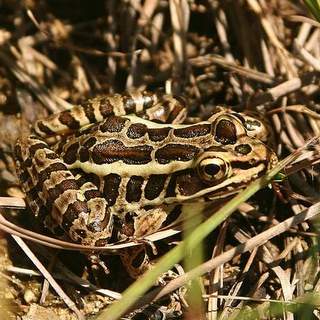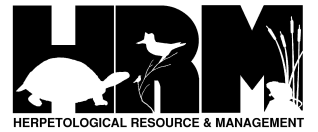Pickerel Frog
Overview:
Scientific Name: Rana palustris
Size: 1.7 – 3.4” (adult length)
Status: Species of Special Concern and Species of Greatest Conservation Need; Uncommon to rare over the Great Lakes region but can be locally abundant where suitable habitat exists.

Habitat:
Found in or near bogs, fens, ponds, streams, springs, sloughs, and lake coves. Prefer cool clear waters. Often inhabit grassy stream banks and areas where streams flow into bogs, marshes, or weedy ponds.
Adult Coloration:
Prominent squarish brown dorsal (back) spots arranged in two irregular rows between light colored dorsolateral folds (raised ridges of skin running down back) on a light brown, tan, gray, or olive background. Spots may be outlined in black. Rarely spots will converge into lengthwise stripes. Groin and undersides of hind legs may be bright yellow, orange, or gold, while throat and belly are whitish.
Adult Characteristics:
Medium sized typical looking frog with prominent spots. Males are slightly smaller with enlarged thumbs during breeding. Voice: Low-pitched, snorelike croak. e.g., http://www.youtube.com/watch?v=RvamqQXtzO8
Larvae Characteristics:
Tadpoles reach maximum length of 2 – 3” before metamorphosis. Back is green, grayish brown, or brown, often with black and yellow spots. Belly is iridescent white or cream. Tail fins with heavy pigmentation in the form of dark spots or blotches.
Species Confused With:
Most similar to Northern Leopard frogs. Tadpoles of Northern Leopard Frogs have less heavily pigmented fins with only light or faint spots, while adults have more rounded spots on the back that are not arranged in rows. The calls of the two species are also similar, but the Pickerel Frog’s call is shorter and does not carry as far as that of the Northern Leopard Frog.
References:
- Amphibians and Reptiles of the Great Lakes Region by Jim Harding
- Harding, J.H. and J.A. Holman. 1992. Michigan Frogs, Toads, and Salamanders. MSU Cooperative Extension Service and MSU Museum. Extension Bull. E-2350, 144 pp.
- Ruthven, A. G., H. B. T. Gaige, et al. 1912. The herpetology of Michigan, by Alexander B. Ruthven. Crystal Thompson and Helen Thompson; Memoranda towards a bibliography of the archaeology of Michigan, by Harlan I. Smith; prepared under the direction of Alexander G. Ruthven. Lansing, Mich., Wynkoop Hallenbeck Crawford, State Printers.
- Holman, J. A. 2012. The Amphibians and Reptiles of Michigan: A Quaternary and Recent Faunal Adventure. Detroit, Mich., Wayne State University Press.
- Conant, R., and Collins, J. T. 1998. Reptiles and Amphibians: Eastern, Central North America. Houghton Mifflin Harcourt Press.
